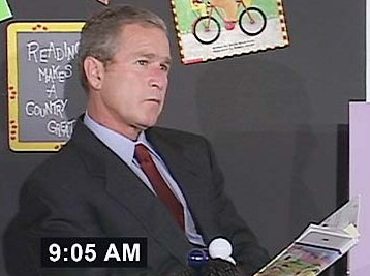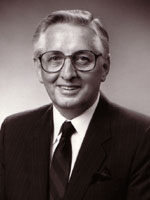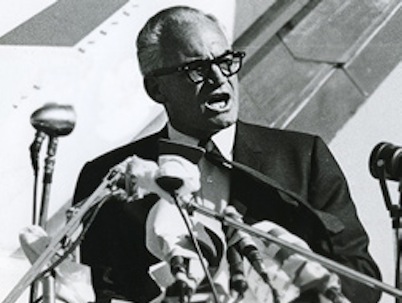I. Bush the Elder
A. Patrician background--Bush's father was an investment banker and senator from Connecticut. Bush, like his father before him--and his sons afterward--attended Philips Andover Academy and Yale University.
B. Public Service and Private Gain--the Bush family, more so than most, was able to make a great deal of private gain from their public service, mainly through connections made with business people.
1. Marriage and college--Bush's education was interrupted by his service, which he entered soon after graduating from Philips in 1942. Bush survived being shot down in the Pacific, and on his return to the US at the close of the war Bush married Barbara Pierce that year; the first child, George, as born in 1946.
2. George Bush, oilman--Bush used family connections to make a great deal of money in the oil business in Texas during the 1950s and early 1960s, so that he was able to retire at the age of 40 from the oil business.
3. Bush the politician--used family connections to finagle one of the few "safe" Republican seats in Texas in the mid-1960s. Bush was not driven by any ideology to get into politics; although he voted against the Civil Rights Act in 1964, he later moderated his position on this issue. For Bush, policy positions were merely a means to get elected.
4. 1980 Presidential election--After he was defeated in a reelection bid in Texas, Bush served as Director of the CIA under Nixon, envoy to China (before formal ties were established with that country), and Chairman of the Republican National Committee. In 1980 he initially ran for president against Ronald Reagan, deriding Reagan's advocacy of "voodoo economics. After agreeing to run as vice-president, however, Bush bit his tongue over any criticism of "supply-side" economics--which proved to be, indeed, voodoo economics.
5. 1988 Presidential campaign--Democratic candidate Michael Dukakis was, at heart, a technocrat, and his no-nonsense approach made him seem lacking in empathy; his explanation that the court system should not be used for personal revenge in answer to a question of how he would react if his wife or daughter were raped made this ad particularly effective;
6. First Gulf War--although a serious diplomatic misstep gave Saddam Hussein what he thought was a green light to invade neighboring Kuwait, diplomatic overtures to European allies created a sizable coalition to fight the Iraqi army, and Operation Desert Storm was a military success.
a. Coalition troops on the Saudi peninsula, home to the two most important holy sites for Muslim, caused consternation among the most devout among them, including a man named Osama bin Laden and those around him--and the group, after the withdrawal of Soviet forces from Afghanistan, set their sites on forcing the US from the Arabian peninsula
b. Bush's popularity--as a result of the success of Operation Desert Storm, George H.W. Bush's popularity soared to over 90 percent.
II. The Clinton Presidency
A. 1992 Election--with Bush's popularity soaring in early 1991, the Democratic Party had difficulty in even persuading viable candidates to run. The candidate who emerged, William Clinton of Arkansas, was the candidate from the new "center" of the Democratic Party, those political leaders who attempted to reconcile the liberal heritage of the New Deal with the political reality (as they saw it) of the post-Reagan years.
1. "It's the economy, stupid!"--Bush's popularity plummeted from its high largely because of the recession that began in late 1991 and continued into early 1992. Bush made a series of political missteps, and seemed to lack resolve on foreign issues even with the success of the Gulf War (Tiananamen Square, the Fall of the Berlin Wall), Clinton was able to attack Bush as being "out of touch" with the common man.
2. The Perot Factor--a third party candidate, running as an independent, attracted a number of voters who would have stayed home, as businessman Ross Perot financed much of his campaign with his own money. For the first time since 1972, election turnout surpassed 55 percent.
3. Clinton and the Venomous Right--Clinton's move to the center stirred a huge resentment among political figures on the political right, who perceived this political posture as besmirching the Reagan legacy. By 1994, after the defeat of the Clinton health care reform plan (head by his wife, Hilary Rodham Clinton), Republicans in the US House of Representatives, under the leadership of the Minority Whip Newton Gingrich, issue a policy statement called the "Contract
4. Clinton and Scandal--Clinton aided and abetted much of this opposition with his personal conduct (where he allowed his "little head to do the thinking--see the John Hiatt video above for an explanation), culminating in the sordid Monica Lewinsky affair that led to his impeachment.
III. Bush the Lesser
A. The Fortunate Son--failed as a Texas Air National Guard pilot, failed as a politician (initially), failed in a number of oil business ventures. Bush junior's luck changed when he was hired to be the public face of the Texas Rangers baseball team during his father's term in office, where he discovered that he excelled at superficial contact with people. After convincing the city of Arlington, Texas, to build the team a new luxury stadium, Bush and his associates were able to sell the team to a numbskull Texas businessman at an inflated price, making Bush a hefty profit on his "investment" (for which Bush put up no money).
B. Texas politics--Bush parlayed this newly developed "good ole boy" persona into political success, defeating the populist Ann Richards and then going on to win a second term.
C. Compassionate conservatism--taking a page from the Clinton political playbook, Bush move toward the center after winning the Republican nomination. His Democratic opponent, Albert Gore, was tainted by the various Clinton scandals, undermined by the mainstream press' dislike for him, and his own stolid demeanor--and still won more popular votes than George W. Bush
1. Bush v. Gore--in an unprecedented move, the activist Rehnquist court voted 5-4, along party lines, to halt the Florida recount that would have given Al Gore the election.
2. The Prejudice of Low Expectations--Many people, particularly those in the media who had seen Bush up close, had low expectations for his accomplishments--and when he was able to somehow exceed those expectations, they confused this with competence.
3. August 6 Presidential Daily Briefing (PDB)--each morning, the President is given an intelligence briefing by his National Security Administration staff. The subject of the August 6 briefing, given while Bush was on vacation at his "ranch" in Texas, was "Osama bin Laden Determined to Strike in US." He told briefer after hearing the report, "Okay, you've covered your ass. Now get out of here."
4. 9/11

























